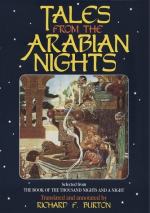[FN#103] “Tusks” not “teeth” which are not valued. As Hole remarks, the elephants of Pliny and Sindbad are equally conscious of the value of ivory. Pliny (viii. 3) quotes Herodotus about the buying of ivories and relates how elephants, when hunted, break their “cornua” (as Juba called them) against a tree trunk by way of ransom. AElian, Plutarch, and Philostratus speak of the linguistic intelligence and religious worship of the “half-reason with the hand,” which the Hindus term “Hathi"=unimanus. Finally, Topsell’s Gesner (p. 152) makes elephants bury their tusks, “which commonly drop out every tenth year.” In Arabian literature the elephant is always connected with India.
[FN#104] This is a true “City of Brass.” (Nuhas asfar=yellow copper), as we learn in Night dcclxxii. It is situated in the “Maghrib” (Mauritania), the region of magic and mystery; and the idea was probably suggested by the grand Roman ruins which rise abruptly from what has become a sandy waste. Compare with this tale “The City of Brass” (Night cclxxii.). In Egypt Nuhas is vulg. pronounced Nihas.
[FN#105] The Bresl. Edit. adds that the seal-ring was of stamped stone and iron, copper and lead. I have borrowed copiously from its vol. vi. pp. 343, et seq.
[FN#106] As this was a well-known pre-Islamitic bard, his appearance here is decidedly anachronistic, probably by intention.
[FN#107] The first Moslem conqueror of Spain whose lieutenant, Tarik, the gallant and unfortunate, named Gibraltar (Jabal al-Tarik).
[FN#108] The colours of the Banu Umayyah (Ommiade) Caliphs were white, of the Banu Abbas (Abbasides) black, and of the Fatimites green. Carrying the royal flag denoted the generalissimo or plenipotentiary.
[FN#109] i.e. Old Cairo, or Fustat: the present Cairo was then a Coptic village founded on an old Egyptian settlement called Lui-Tkeshroma, to which belonged the tanks on the hill and the great well, Bir Yusuf, absurdly attributed to Joseph the Patriarch. Lui is evidently the origin of Levi and means a high priest (Brugsh ii. 130) and his son’s name was Roma.
[FN#110] I cannot but suspect that this is a clerical error for “Al-Samanhudi,” a native of Samanhud (Wilkinson’s “Semenood”) in the Delta on the Damietta branch, the old Sebennytus (in Coptic Jem-nuti=Jem the God), a town which has produced many distinguished men in Moslem times. But there is also a Samhud lying a few miles down stream from Denderah and, as its mounds prove, it is an ancient site.
[FN#111] Egypt had not then been conquered from the Christians.
[FN#112] Arab. “Kizan fukka’a,” i.e. thin and slightly porous earthenware jars used for Fukka’a, a fermented drink, made of barley or raisins.
[FN#113] I retain this venerable blunder: the right form is Samum, from Samm, the poison-wind.
[FN#114] i.e. for worship and to prepare for futurity.




